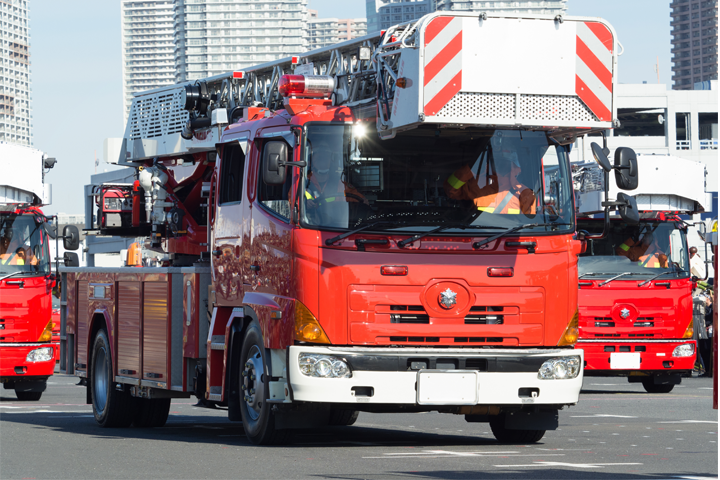Tokyo’s Fire Museum, dedicated to the history of fire-fighting in the city, is housed in the fortress-like Yotsuya Fire Station in Shinjuku Ward. The museum offers a vivid introduction to both past and current fire-fighting efforts. Admission is free and most exhibits come with English-language explanations.

The Types of Exhibits Found In The Fire Museum
Basement Level
The Fire Museum can be entered on its basement floor straight from Exit 2 of Yotsuya-sanchome Station on the Marunouchi Subway Line. Entering on the basement level, you walk right into the museum’s collection of vintage fire engines, many of them dating back to the 1920’s. All of them were in service in Tokyo in their time though they are mostly of foreign origin, imported from the U.S., France and Germany.
Ground Level
The museum’s lobby on street level greets visitors with a French-made fire-fighter helicopter from the 1960’s, in service in Tokyo until the early 1980’s. The historical exhibitions are arranged in chronological order, starting on the 5th floor. Take the elevator up, then continue down the stairway. The 5th floor introduces the beginnings of organized fire-fighting in the 17th century, during the Edo Period.
Edo, as Tokyo was called then, was a city built almost entirely of wood. In the downtown areas, streets were narrow, the structures densely clustered. All cooking, all heating, all lighting was done using more or less open fire. A small mistake in handling a candle alone could destroy whole neighbourhoods. Unfortunately, this kind of accidents happened quite frequently.
While in the early days, the neighbourhoods would put up their own efforts, in the early 17th century the Tokugawa Shogunate introduced a centralized system, centering on local fire / police stations called jishinban that served to combat both fire and crime.
In the event of a fire, a fire-fighter squad made up of samurai would be dispatched to the afflicted area. Their job was however not to extinguish the blaze but to prevent its spreading. Depending on wind direction and local geography, the samurai leading the squad would decide which houses had to be torn down to keep the fire in as small a locality as possible. People fleeing the afflicted area were strictly prohibited to take any personal belongings with them as that would hamper the fire-fighting effort. Tough measures and not always successful but the brave hikeshi, as firemen were called back then, did the best they could.
5th Floor
The exhibits on the 5th floor include scale models of such fire-fighting work in progress, replicas of fire fig hers’ uniforms of the time and plenty of pictorial material, including woodblock prints by ukiyo-e master Hiroshige Utagawa (1797-1858). Hiroshige had first-hand experience on what he depicted – he worked for many years as a town official and active fire-fighter.
On the 5th floor, you can also enter the rooftop. An actual fire-fighter helicopter, built in France in the 1960’s and in service in Tokyo until the 1980’s, is on display outside. The helicopter can be entered, offering a unique perspective of the city from the pilot’s seat.
4th Floor
The 4th floor of the museum focuses on the progress made during the Meiji, Taisho and early Showa periods when Japan opened up to the outside world and introduced many Western technologies. This applied also to fire-fighting. Western-style fire engines (first horse powered, then motorized) came into service as well as modern water pump systems, fire alarms and so on. Picture material in this section includes photos of the Great Kanto Earthquake in 1923 and the Shirokiya department store fire in 1932.
2nd & 3rd Floor
The 3rd floor features the development of current fire protection and fire-fighting from post-World War II years up to today. The 2nd floor of the building is not part of the museum and off-limits to visitors. It houses the offices of today’s Yotsuya Fire Station.
10th Floor
An elevator ride up to the 10th floor, the top floor of the building, leads to the Observation Deck. It is, in fact a room equipped with drink vending machines, tables and chairs. Eating is permitted here. The 10th floor glass fronts offer good views over central Tokyo, especially towards the Shinjuku skyline and, on the opposite side, the Tokyo Skytree.
More Information
Fire Museum
3-10 Yotsuya, Shinjuku-ku, Tokyo 101-8301
Access
The Marunouchi Subway Line of Tokyo metro to Yotsuya-sanchome Station. Exit 2 of the station leads right to the basement level entrance of the museum.
Admission
Free admission
Opening Hours
Tuesday to Sunday from 9.30am to 5pm, closed on Mondays (unless Monday is a national holiday in which case the museum is closed the following day) and over the New Year period (December 28th to January 4th).